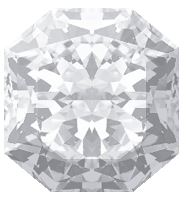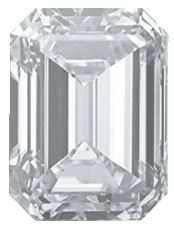Table & Depth
A diamond’s proportions, with primary focus placed upon depth rather than diameter, make select stones incredibly valuable. While a diamond’s diameter itself may not necessarily be relevant, its table diameter is. Understanding both depth and table values is incredibly important for valuable stone enthusiasts, and it assists consumers when making decisions.
Diamond Depth
Diamond depth is depicted through its height in millimeters. When measuring depth, diamond cutters measure distances between the stone’s cutlet and table. When featured upon a grading report, a diamond typically contains two separate depth measurements.

Radiant shaped diamond with 91.3% depth
First, the stone’s depth is featured beneath a “measurement” report. The stone’s second depth is considered a relative percentage value. This percentage shows a diamond’s depth with relation to width.
Modern diamond polishing is considered an art, so depth percentage is incredibly relevant when identifying and highlighting a stone’s proportions. A high depth percentage reveals several qualities, and each is important to determining a stone’s worth. These qualities include:
- *Brilliance
- *Proportional width
- *Overall potential value
- *Sparkle
As stated above, a diamond’s sparkle may be ascertained through its depth measurements. Extreme depth is utilized to depict a diamond’s overall beauty. Specifically, a diamond’s pavilion, when cut correctly, grants entering light the ability to rebound across the stone’s interior. When reflected out of the diamond, and into a viewer’s eye, the flash is denoted as “sparkle”: a feature measurable through its birthing mechanics.
Diamond Table
Diamond table is the stone’s flattened facet upon its topmost area. When a diamond is positioned face up, its table is its largest portion, and it plays an integral role where light performance and brilliance are concerned.
Emerald shaped diamond with 83% table
A diamond’s table serves light refraction, as its structure grants light rays the ability to be reflected within a diamond’s depth—into the stone’s pavilion area and returning to the viewer’s eye.
Unlike depth, however, larger table percentages sometimes result in less-vibrant diamonds, as a larger table may result in rounder surfaces, reducing the stone’s fire and reflective qualities. Due to a diamond’s finite area available within its crown area, larger tables often result in less surface area, resulting in decreased light dispersion. Similarly, diamonds with relatively small tables grant the following features:
- *Increased light magnificence
- *Increased reflective quality through dispersion
- *Enhanced color vibrancy
A small table can, however, reduce magnificence when not paired correctly with depth. Ideally, striking a comfortable balance between table and depth increases a stone’s overall light transmission, increasing its fire and enhancing its value.

